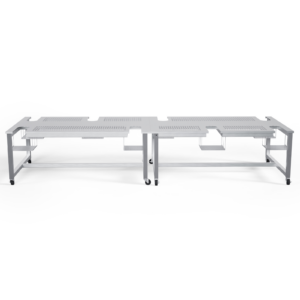Microsoft is just the latest high-profile tech company that has put its employees on notice that they’d like them to resume coming back to the office.
But there is more to it than making a simple request.
How should management prepare workers to come back to the office? What steps can they take to create a renewed work culture where people once again meet face-to-face?
We look at 10 aspects to keep in mind when requesting your employees to return to the office, whether it’s on a full-time basis or part of a hybrid work strategy where they continue to work from home several days a week.

1. Create a Formal ‘Welcome Back’ Plan and communicate it clearly to your Employees
This may seem like an obvious step, but you need to create a plan to welcome employees back to the office.
Why?
People are naturally going to have a lot of questions about returning to work in person, including:
- What are the policies for vaccination and wearing masks on the job?
- What can be done for at-risk people (such as those with compromised immune systems) while not violating their HIPAA medical privacy?
- People have been wearing dress shirts on Zoom but often in combination with shorts or sweats. So many will ask, ‘what will be the new dress code at work?’
- Should employees report a colleague who appears to be unwell (coughing, etc.), and if so, what is the best way to do it?
- Will there be onsite Covid testing available?
- If you do get sick, what are the current policies on sick leave and healthcare coverage?
- What food and drink options are there? Will the communal kitchen mess be open? What about the cafeteria? What restaurants and coffee shops are still open near the workplace?
- How is the office, including the kitchen and restrooms, being sanitized?
- Is the office HVAC system filtering the air?

Employees will also need to explore their options for commuting as many public transport services have cut back over the past two years, and there may be new construction projects that lead to a longer drive into work. (It’s also good to remind workers to be careful on the roads, as highway accidents are at a record high post-pandemic.)
As you can see from the points above, you’ll probably want to conduct a re-orientation session with workers as part of your welcome back planning.
But you might also want to do what new restaurants often do, e.g. conduct a “soft-opening” where you give employees the option to come in and test the waters – to see what changes have happened in the office first hand prior to calling everyone together for an official “all hands” orientation meeting.
2. Make everyone comfortable: Mitigate feelings of anxiety for yourself and others
Managers are likely very eager to welcome workers back to the office.
They are eager to return to the status quo ante Covid, where people exchanged ideas spontaneously, thanks to those serendipitous encounters, often resulting in unexpected new insights while helping to tear down the silos that keep different departments apart.
But while managers may be eager to bring people back to the office, not everyone will have the same reaction.
The extroverts on your staff may yell “hallelujah” – happy to see the backside of the Zoom application – in hopes of never having to shout “you’re on mute!” ever again!
But the more introverted staff members may feel quite different, even resistant to the idea of returning to the office. For some of these workers, the idea of returning to face-to-face meetings could create a huge amount of anxiety. Don’t try to brush past or minimize these feelings, as they can be very real.
Anxiety may also plague workers who have adjusted their lifestyles to capitalize on working from home (WFH).
For example, the flexibility that working from home offered may have allowed parents to look after their kids (rather than pay for childcare), and now, they either need to let the spouse shoulder all the responsibility, or they need to find childcare. A similar situation exists with employees providing elder care for an aging parent or relative living at home.

Many people also adopted a pet during the pandemic and will need to figure out how to get a pet sitter. (Creating policies to offer childcare at work or to allow pets at work might be well received and could help with employee retention.)
3. Purposefully mix People and Projects (to tear down Silos that arose during the Pandemic)
New group dynamics likely emerged during the pandemic.
Online collaboration tools (such as Slack or Zoom) might have brought some people closer together, while others may feel less connected to those employees in distant departments outside the circle of their close co-workers.
As a manager, this is a good time to address these issues.
The organization as a whole might benefit from performing a reset.
For example, you might choose to organize people who don’t know each other well (due to the pandemic) to work on projects together to build a stronger team.
You might also want to encourage your introverts (who thrived in online communication) to re-engage with the extroverts who felt left out or disengaged during the pandemic.
4. Brush up on Interpersonal Skills to Avoid Unnecessary Social Faux Pas
What does it feel like to come back to the office after as long as two years away?
For some, it may feel like returning to grade school after a long summer vacation, wearing all new clothes, and wondering who will be in your class and what your teacher will be like.
We can take this humorous analogy a little further…
Much like schoolchildren who have been away from school for an extended vacation, we too need to reacclimatize ourselves with good social skills and etiquette when returning to the world of social interaction in the office.
It might be helpful to practice little small talk topics and ice breakers (including the inevitable ‘what I did over the Covid break’) in advance.
You might also want to tell yourself that under no circumstances should you comment on someone else’s personal appearance as they might be very self-conscious of having gained weight (as so many have during the pandemic), and inevitably, everyone is a couple of years older than before the pandemic (so no old age jokes please!).
These rules apply not only in the office but also when you meet customers and suppliers as well.
In fact, when you leave the office to attend an event or make a sales call, don’t forget these items as well:
- Working face-to-face is different than working on Zoom. You’ll need to memorize people’s names, for example. There won’t be a label underneath the person’s face with their name on it.
- You will also want to replenish your supply of business cards to hand out during sales calls and events.
- Practice your presentations before you make them in person; you may be a little rusty or have gotten dependent on having your notes in front of you (but just out of sight of the Zoom camera)

5. Make the Most of Impromptu Encounters, especially if you are working a Hybrid Schedule
As we noted at the beginning, managers are excited to bring people back to the office so they can once again have those chance encounters that can lead to greater insight and creativity on the job – something that was difficult to achieve relying only on Zoom conference calls.
Chance favors the prepared mind.
— Louis Pasteur
But you can help ‘chance’ work better, especially if you are working a hybrid schedule.
Make the most of hybrid work by coordinating your schedule with those you would like to meet up with face-to-face.
Facility managers can also help encourage easy face-to-face communication and serendipitous encounters as well by creating impromptu seating areas, casual meeting spaces, and offering onsite cafeteria and coffee/beverage stations where people can congregate and strike up conversations on the job.

6. Be Productive in Meetings by Communicating Effectively
Face-to-face meetings also have a different personal dynamic compared to Zoom conference calls.
Indeed, they can be much more effective, but only if you are savvy about making sure everyone gets heard.
Don’t fall into the trap of letting the loudest, most aggressive people take control of the conversation. And don’t fall into groupthink patterns either. For example, resist the temptation to obediently agree with the HiPPO (highest paid person in the office).
Be polite, attentive, and thoughtful when expressing your point of view, and encourage those less comfortable to speak their mind.
Establish a timekeeper and a note-taker, and decide if it’s ok for people to take notes on their personal devices (notebooks, tablets, etc.) – a habit that many of us learned while attending zoom meetings when working from home.
Remember to follow the best practices during brainstorming meetings, e.g. no idea is a bad idea when you are throwing suggestions up on a whiteboard.
And finally, take measures to include those participants who may be attending virtually from home or from remote offices. (More on this in point #10 below).
7. Build your Team and Welcome New Members (Consider it Belated In-Person Onboarding)
One of the most challenging aspects of managing an organization during the pandemic has been the practice of hiring new workers and giving them a virtual onboarding.
Now is the time to make up for these lost opportunities by providing new workers a proper introduction to the staff, the work environment, and the company’s mission and vision for the future.
It might be a good time to pull out Bruce Tuckman’s Forming, Storming, Norming, and Performing playbook as a means to re-introduce your team members to one another and establish a new basis for working together face-to-face once again.
You can also reach out beyond your immediate team as well.
Why not create plans and activities to re-engage with valued customers and suppliers, either by inviting them to join you at the office for an appreciation celebration or going on the road to reconnect in-person with those who you may have only spoken to on a Zoom call.
8. Mentor Employees Face-to-Face, Especially the New Hires
Related to the task of onboarding new employees is the need to mentor.
While it was possible to provide mentoring via Zoom, it can come across as stilted and even impersonal.
Now that we are re-engaging face-to-face, why not strike up a new initiative to match employees with more experienced workers who can offer nuanced, personal guidance on topics ranging from how to perform better on the job to long-range career counseling.
For specific ideas on how to set up such a program, take a look at our recent article Create and Grow a Successful Mentorship Program within Your Business Organization.
9. Increase Management Visibility (Managing Up and Down) as well as Improve Team Member Evaluations
One of the most challenging issues during the pandemic was how to provide the right level of management visibility for those employees working from home.
It’s proven to be a Goldilocks style dilemma – if your management style is too intrusive (from the employee’s perspective), you can be considered an unhelpful micromanager. On the other hand, if your style is considered to be a light touch, your workers might consider you to be absent and disconnected.
(Employee monitoring software also comes into play here, some companies are using these tools to keep tabs on employee productivity, but there are privacy concerns that may outweigh any perceived benefits. Keep an eye out for a future article where we delve into the issues involved.)
Another related issue that has bedeviled many managers with direct reports working from home is how to evaluate their job performance without being able to closely observe them on a day-to-day basis.
Many employees working from home have also expressed concerns that they may not be getting adequate “face time” with the boss, possibly putting their career advancement aspirations in the slow lane.
Fortunately, managers can brush up on their tried-and-true, pre-pandemic employee evaluation strategies and put them to work for employees who are returning to the office.

10. Support Offsite Colleagues; Don’t Leave Them Behind
But what about employees who will continue to work from home most of the time?
You will need to be flexible, as some employees would rather quit than return to the office.
They may have good reasons to stay at home. Perhaps, as we touched on at the beginning, they are responsible for at-home child or elder care. Or perhaps they moved far away from the office during the height of the pandemic and can’t make a lengthy commute.
Providing some accommodation on a case-by-case basis is reasonable, particularly for hard-to-replace employees. (Some employers are now renting local offices for remote workers to meet up.)
But the bigger message is there will be a need to support offsite colleagues in general.
Let’s assume your policy is to establish a hybrid work schedule, with employees coming into the office only two or three days a week.
On an average day, you’ll need to find practical ways to accommodate a significant percentage of workers who are working from home.
This means investing in better telecommunications at work, such as better quality teleconference systems in conference rooms.

We hope you’ve found our guide to how to improve face-to-face communication in the office.
If you have further suggestions, we’d love to hear them. Let us know!
Formaspace is Your Partner for the Future of Work
If you can imagine it, we can build it, here at our Formaspace factory headquarters in Austin, Texas.
Talk to your Formaspace Design Consultant today and see how we can work together to make a more inviting, comfortable, and ergonomically sound workplace where your employees look forward to coming in to work.









